International Law and Conflict Resolution
VerifiedAdded on 2020/10/22
|12
|4042
|272
AI Summary
This assignment delves into various aspects of international law and conflict resolution, including the use of power laws to estimate conflict size, public debt, life expectancy, and environmental quality. It also touches on alternative dispute resolution methods in labor law and the principles and practice of international commercial arbitration. The resources provided include academic papers, books, and online articles that offer a comprehensive understanding of these topics.
Contribute Materials
Your contribution can guide someone’s learning journey. Share your
documents today.

INTERNATIONAL
ENVIRONMENTAL LAW
ENVIRONMENTAL LAW
Secure Best Marks with AI Grader
Need help grading? Try our AI Grader for instant feedback on your assignments.
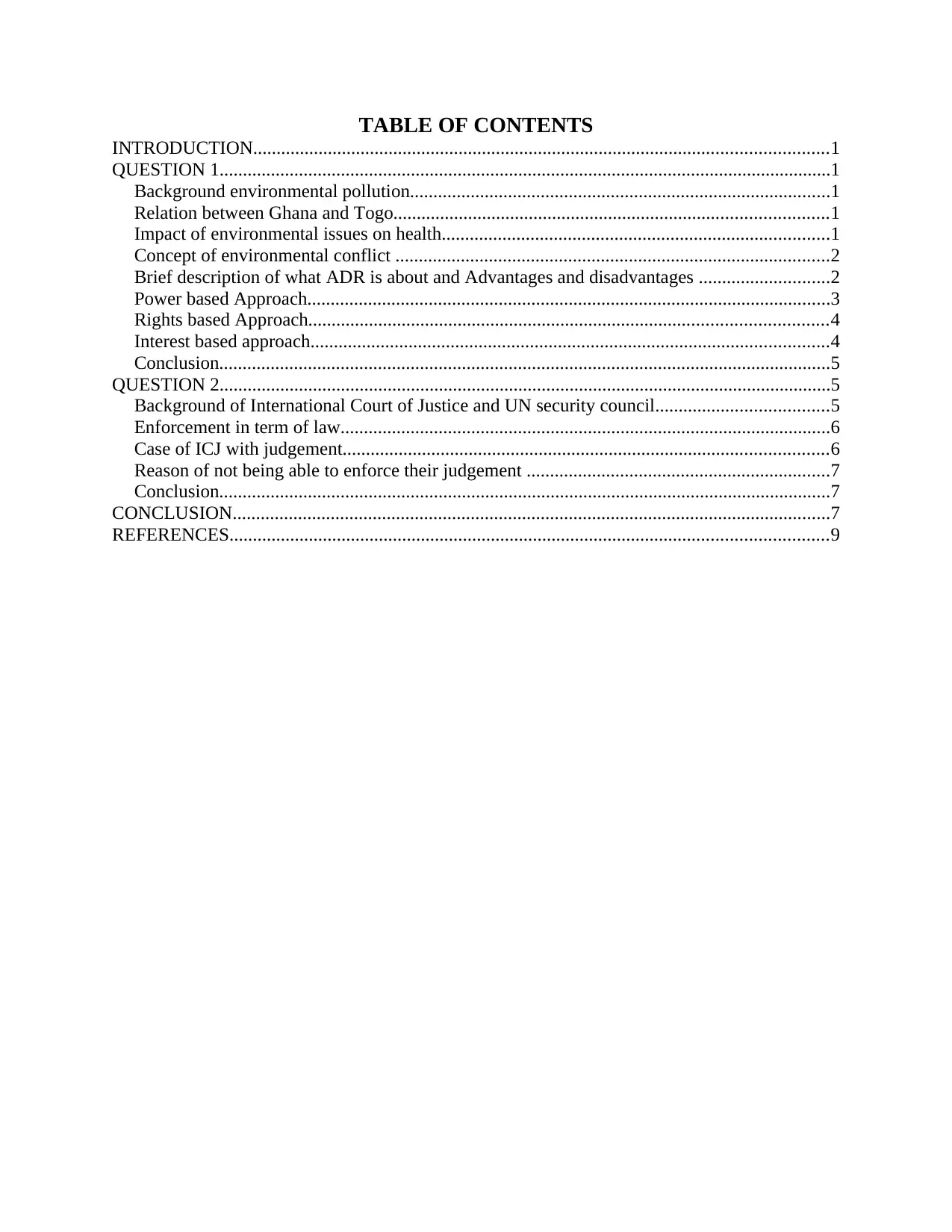
TABLE OF CONTENTS
INTRODUCTION...........................................................................................................................1
QUESTION 1...................................................................................................................................1
Background environmental pollution..........................................................................................1
Relation between Ghana and Togo.............................................................................................1
Impact of environmental issues on health...................................................................................1
Concept of environmental conflict .............................................................................................2
Brief description of what ADR is about and Advantages and disadvantages ............................2
Power based Approach................................................................................................................3
Rights based Approach...............................................................................................................4
Interest based approach...............................................................................................................4
Conclusion...................................................................................................................................5
QUESTION 2...................................................................................................................................5
Background of International Court of Justice and UN security council.....................................5
Enforcement in term of law.........................................................................................................6
Case of ICJ with judgement........................................................................................................6
Reason of not being able to enforce their judgement .................................................................7
Conclusion...................................................................................................................................7
CONCLUSION................................................................................................................................7
REFERENCES................................................................................................................................9
INTRODUCTION...........................................................................................................................1
QUESTION 1...................................................................................................................................1
Background environmental pollution..........................................................................................1
Relation between Ghana and Togo.............................................................................................1
Impact of environmental issues on health...................................................................................1
Concept of environmental conflict .............................................................................................2
Brief description of what ADR is about and Advantages and disadvantages ............................2
Power based Approach................................................................................................................3
Rights based Approach...............................................................................................................4
Interest based approach...............................................................................................................4
Conclusion...................................................................................................................................5
QUESTION 2...................................................................................................................................5
Background of International Court of Justice and UN security council.....................................5
Enforcement in term of law.........................................................................................................6
Case of ICJ with judgement........................................................................................................6
Reason of not being able to enforce their judgement .................................................................7
Conclusion...................................................................................................................................7
CONCLUSION................................................................................................................................7
REFERENCES................................................................................................................................9
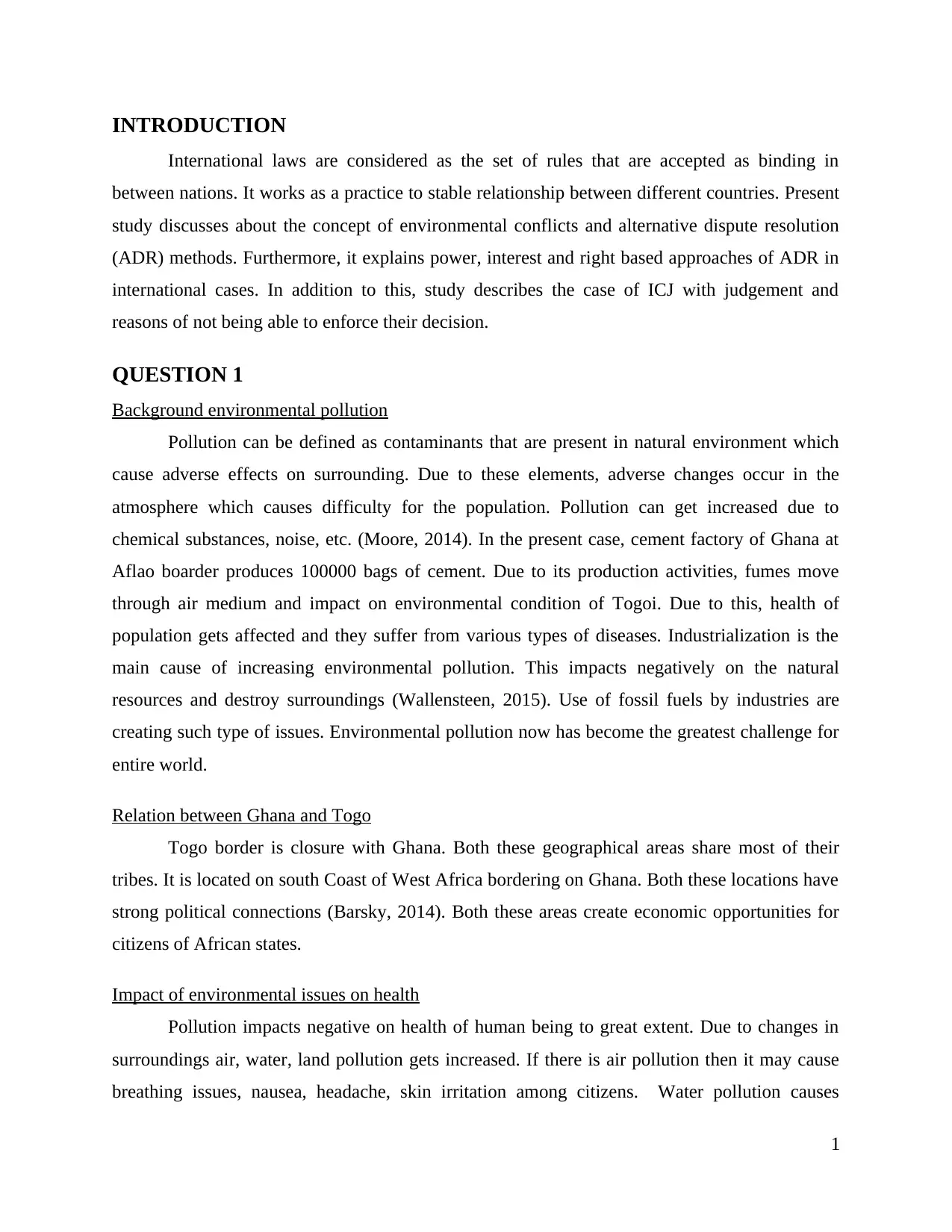
INTRODUCTION
International laws are considered as the set of rules that are accepted as binding in
between nations. It works as a practice to stable relationship between different countries. Present
study discusses about the concept of environmental conflicts and alternative dispute resolution
(ADR) methods. Furthermore, it explains power, interest and right based approaches of ADR in
international cases. In addition to this, study describes the case of ICJ with judgement and
reasons of not being able to enforce their decision.
QUESTION 1
Background environmental pollution
Pollution can be defined as contaminants that are present in natural environment which
cause adverse effects on surrounding. Due to these elements, adverse changes occur in the
atmosphere which causes difficulty for the population. Pollution can get increased due to
chemical substances, noise, etc. (Moore, 2014). In the present case, cement factory of Ghana at
Aflao boarder produces 100000 bags of cement. Due to its production activities, fumes move
through air medium and impact on environmental condition of Togoi. Due to this, health of
population gets affected and they suffer from various types of diseases. Industrialization is the
main cause of increasing environmental pollution. This impacts negatively on the natural
resources and destroy surroundings (Wallensteen, 2015). Use of fossil fuels by industries are
creating such type of issues. Environmental pollution now has become the greatest challenge for
entire world.
Relation between Ghana and Togo
Togo border is closure with Ghana. Both these geographical areas share most of their
tribes. It is located on south Coast of West Africa bordering on Ghana. Both these locations have
strong political connections (Barsky, 2014). Both these areas create economic opportunities for
citizens of African states.
Impact of environmental issues on health
Pollution impacts negative on health of human being to great extent. Due to changes in
surroundings air, water, land pollution gets increased. If there is air pollution then it may cause
breathing issues, nausea, headache, skin irritation among citizens. Water pollution causes
1
International laws are considered as the set of rules that are accepted as binding in
between nations. It works as a practice to stable relationship between different countries. Present
study discusses about the concept of environmental conflicts and alternative dispute resolution
(ADR) methods. Furthermore, it explains power, interest and right based approaches of ADR in
international cases. In addition to this, study describes the case of ICJ with judgement and
reasons of not being able to enforce their decision.
QUESTION 1
Background environmental pollution
Pollution can be defined as contaminants that are present in natural environment which
cause adverse effects on surrounding. Due to these elements, adverse changes occur in the
atmosphere which causes difficulty for the population. Pollution can get increased due to
chemical substances, noise, etc. (Moore, 2014). In the present case, cement factory of Ghana at
Aflao boarder produces 100000 bags of cement. Due to its production activities, fumes move
through air medium and impact on environmental condition of Togoi. Due to this, health of
population gets affected and they suffer from various types of diseases. Industrialization is the
main cause of increasing environmental pollution. This impacts negatively on the natural
resources and destroy surroundings (Wallensteen, 2015). Use of fossil fuels by industries are
creating such type of issues. Environmental pollution now has become the greatest challenge for
entire world.
Relation between Ghana and Togo
Togo border is closure with Ghana. Both these geographical areas share most of their
tribes. It is located on south Coast of West Africa bordering on Ghana. Both these locations have
strong political connections (Barsky, 2014). Both these areas create economic opportunities for
citizens of African states.
Impact of environmental issues on health
Pollution impacts negative on health of human being to great extent. Due to changes in
surroundings air, water, land pollution gets increased. If there is air pollution then it may cause
breathing issues, nausea, headache, skin irritation among citizens. Water pollution causes
1
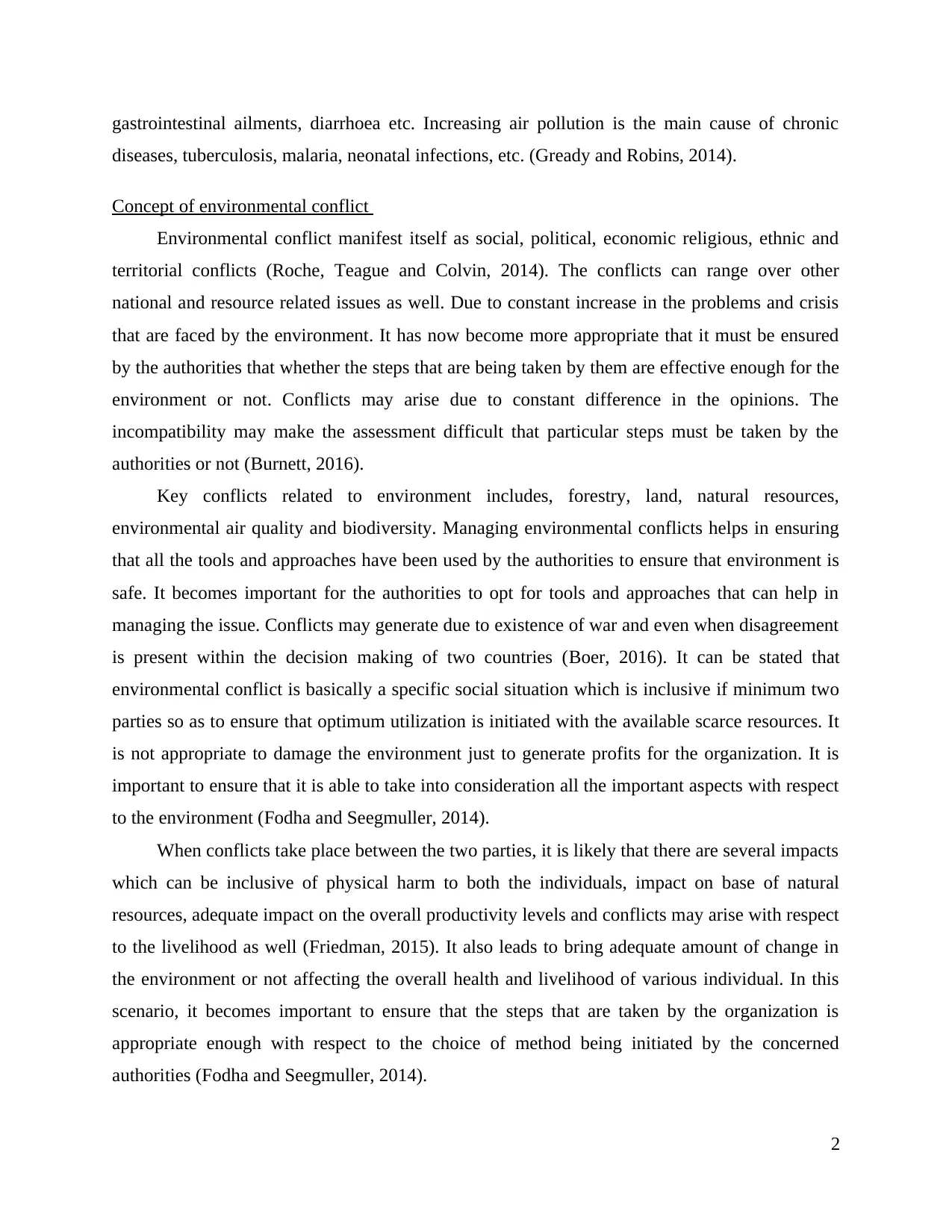
gastrointestinal ailments, diarrhoea etc. Increasing air pollution is the main cause of chronic
diseases, tuberculosis, malaria, neonatal infections, etc. (Gready and Robins, 2014).
Concept of environmental conflict
Environmental conflict manifest itself as social, political, economic religious, ethnic and
territorial conflicts (Roche, Teague and Colvin, 2014). The conflicts can range over other
national and resource related issues as well. Due to constant increase in the problems and crisis
that are faced by the environment. It has now become more appropriate that it must be ensured
by the authorities that whether the steps that are being taken by them are effective enough for the
environment or not. Conflicts may arise due to constant difference in the opinions. The
incompatibility may make the assessment difficult that particular steps must be taken by the
authorities or not (Burnett, 2016).
Key conflicts related to environment includes, forestry, land, natural resources,
environmental air quality and biodiversity. Managing environmental conflicts helps in ensuring
that all the tools and approaches have been used by the authorities to ensure that environment is
safe. It becomes important for the authorities to opt for tools and approaches that can help in
managing the issue. Conflicts may generate due to existence of war and even when disagreement
is present within the decision making of two countries (Boer, 2016). It can be stated that
environmental conflict is basically a specific social situation which is inclusive if minimum two
parties so as to ensure that optimum utilization is initiated with the available scarce resources. It
is not appropriate to damage the environment just to generate profits for the organization. It is
important to ensure that it is able to take into consideration all the important aspects with respect
to the environment (Fodha and Seegmuller, 2014).
When conflicts take place between the two parties, it is likely that there are several impacts
which can be inclusive of physical harm to both the individuals, impact on base of natural
resources, adequate impact on the overall productivity levels and conflicts may arise with respect
to the livelihood as well (Friedman, 2015). It also leads to bring adequate amount of change in
the environment or not affecting the overall health and livelihood of various individual. In this
scenario, it becomes important to ensure that the steps that are taken by the organization is
appropriate enough with respect to the choice of method being initiated by the concerned
authorities (Fodha and Seegmuller, 2014).
2
diseases, tuberculosis, malaria, neonatal infections, etc. (Gready and Robins, 2014).
Concept of environmental conflict
Environmental conflict manifest itself as social, political, economic religious, ethnic and
territorial conflicts (Roche, Teague and Colvin, 2014). The conflicts can range over other
national and resource related issues as well. Due to constant increase in the problems and crisis
that are faced by the environment. It has now become more appropriate that it must be ensured
by the authorities that whether the steps that are being taken by them are effective enough for the
environment or not. Conflicts may arise due to constant difference in the opinions. The
incompatibility may make the assessment difficult that particular steps must be taken by the
authorities or not (Burnett, 2016).
Key conflicts related to environment includes, forestry, land, natural resources,
environmental air quality and biodiversity. Managing environmental conflicts helps in ensuring
that all the tools and approaches have been used by the authorities to ensure that environment is
safe. It becomes important for the authorities to opt for tools and approaches that can help in
managing the issue. Conflicts may generate due to existence of war and even when disagreement
is present within the decision making of two countries (Boer, 2016). It can be stated that
environmental conflict is basically a specific social situation which is inclusive if minimum two
parties so as to ensure that optimum utilization is initiated with the available scarce resources. It
is not appropriate to damage the environment just to generate profits for the organization. It is
important to ensure that it is able to take into consideration all the important aspects with respect
to the environment (Fodha and Seegmuller, 2014).
When conflicts take place between the two parties, it is likely that there are several impacts
which can be inclusive of physical harm to both the individuals, impact on base of natural
resources, adequate impact on the overall productivity levels and conflicts may arise with respect
to the livelihood as well (Friedman, 2015). It also leads to bring adequate amount of change in
the environment or not affecting the overall health and livelihood of various individual. In this
scenario, it becomes important to ensure that the steps that are taken by the organization is
appropriate enough with respect to the choice of method being initiated by the concerned
authorities (Fodha and Seegmuller, 2014).
2
Secure Best Marks with AI Grader
Need help grading? Try our AI Grader for instant feedback on your assignments.
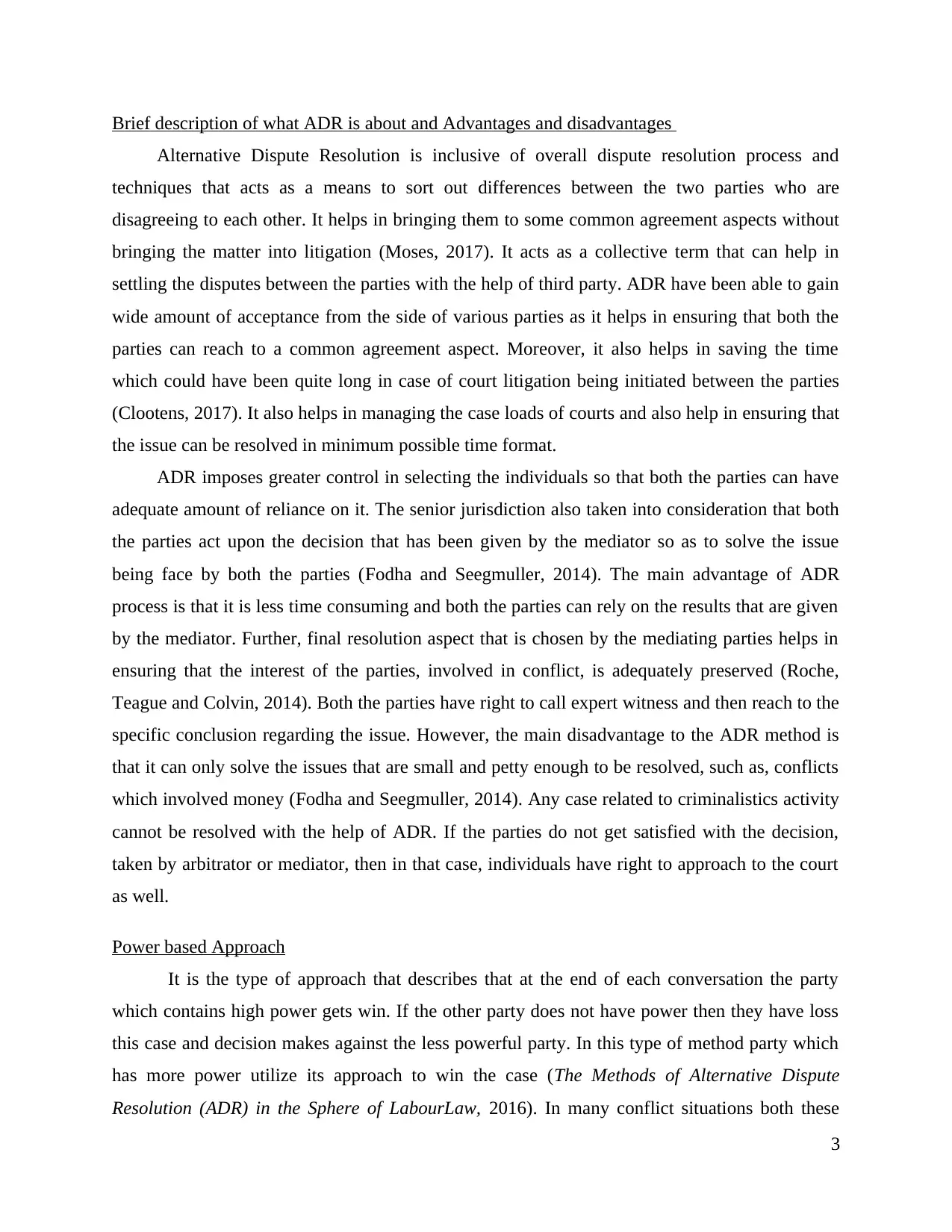
Brief description of what ADR is about and Advantages and disadvantages
Alternative Dispute Resolution is inclusive of overall dispute resolution process and
techniques that acts as a means to sort out differences between the two parties who are
disagreeing to each other. It helps in bringing them to some common agreement aspects without
bringing the matter into litigation (Moses, 2017). It acts as a collective term that can help in
settling the disputes between the parties with the help of third party. ADR have been able to gain
wide amount of acceptance from the side of various parties as it helps in ensuring that both the
parties can reach to a common agreement aspect. Moreover, it also helps in saving the time
which could have been quite long in case of court litigation being initiated between the parties
(Clootens, 2017). It also helps in managing the case loads of courts and also help in ensuring that
the issue can be resolved in minimum possible time format.
ADR imposes greater control in selecting the individuals so that both the parties can have
adequate amount of reliance on it. The senior jurisdiction also taken into consideration that both
the parties act upon the decision that has been given by the mediator so as to solve the issue
being face by both the parties (Fodha and Seegmuller, 2014). The main advantage of ADR
process is that it is less time consuming and both the parties can rely on the results that are given
by the mediator. Further, final resolution aspect that is chosen by the mediating parties helps in
ensuring that the interest of the parties, involved in conflict, is adequately preserved (Roche,
Teague and Colvin, 2014). Both the parties have right to call expert witness and then reach to the
specific conclusion regarding the issue. However, the main disadvantage to the ADR method is
that it can only solve the issues that are small and petty enough to be resolved, such as, conflicts
which involved money (Fodha and Seegmuller, 2014). Any case related to criminalistics activity
cannot be resolved with the help of ADR. If the parties do not get satisfied with the decision,
taken by arbitrator or mediator, then in that case, individuals have right to approach to the court
as well.
Power based Approach
It is the type of approach that describes that at the end of each conversation the party
which contains high power gets win. If the other party does not have power then they have loss
this case and decision makes against the less powerful party. In this type of method party which
has more power utilize its approach to win the case (The Methods of Alternative Dispute
Resolution (ADR) in the Sphere of LabourLaw, 2016). In many conflict situations both these
3
Alternative Dispute Resolution is inclusive of overall dispute resolution process and
techniques that acts as a means to sort out differences between the two parties who are
disagreeing to each other. It helps in bringing them to some common agreement aspects without
bringing the matter into litigation (Moses, 2017). It acts as a collective term that can help in
settling the disputes between the parties with the help of third party. ADR have been able to gain
wide amount of acceptance from the side of various parties as it helps in ensuring that both the
parties can reach to a common agreement aspect. Moreover, it also helps in saving the time
which could have been quite long in case of court litigation being initiated between the parties
(Clootens, 2017). It also helps in managing the case loads of courts and also help in ensuring that
the issue can be resolved in minimum possible time format.
ADR imposes greater control in selecting the individuals so that both the parties can have
adequate amount of reliance on it. The senior jurisdiction also taken into consideration that both
the parties act upon the decision that has been given by the mediator so as to solve the issue
being face by both the parties (Fodha and Seegmuller, 2014). The main advantage of ADR
process is that it is less time consuming and both the parties can rely on the results that are given
by the mediator. Further, final resolution aspect that is chosen by the mediating parties helps in
ensuring that the interest of the parties, involved in conflict, is adequately preserved (Roche,
Teague and Colvin, 2014). Both the parties have right to call expert witness and then reach to the
specific conclusion regarding the issue. However, the main disadvantage to the ADR method is
that it can only solve the issues that are small and petty enough to be resolved, such as, conflicts
which involved money (Fodha and Seegmuller, 2014). Any case related to criminalistics activity
cannot be resolved with the help of ADR. If the parties do not get satisfied with the decision,
taken by arbitrator or mediator, then in that case, individuals have right to approach to the court
as well.
Power based Approach
It is the type of approach that describes that at the end of each conversation the party
which contains high power gets win. If the other party does not have power then they have loss
this case and decision makes against the less powerful party. In this type of method party which
has more power utilize its approach to win the case (The Methods of Alternative Dispute
Resolution (ADR) in the Sphere of LabourLaw, 2016). In many conflict situations both these
3
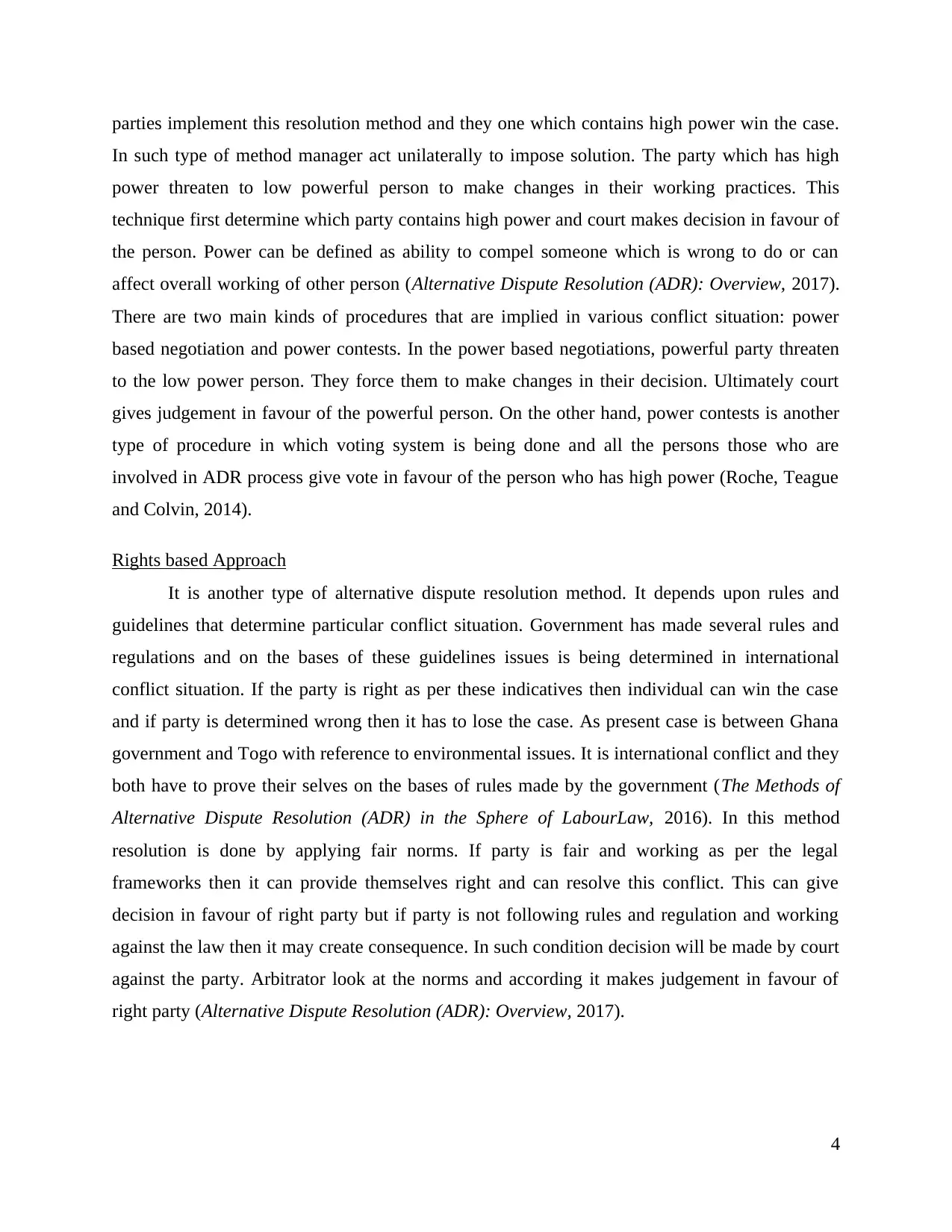
parties implement this resolution method and they one which contains high power win the case.
In such type of method manager act unilaterally to impose solution. The party which has high
power threaten to low powerful person to make changes in their working practices. This
technique first determine which party contains high power and court makes decision in favour of
the person. Power can be defined as ability to compel someone which is wrong to do or can
affect overall working of other person (Alternative Dispute Resolution (ADR): Overview, 2017).
There are two main kinds of procedures that are implied in various conflict situation: power
based negotiation and power contests. In the power based negotiations, powerful party threaten
to the low power person. They force them to make changes in their decision. Ultimately court
gives judgement in favour of the powerful person. On the other hand, power contests is another
type of procedure in which voting system is being done and all the persons those who are
involved in ADR process give vote in favour of the person who has high power (Roche, Teague
and Colvin, 2014).
Rights based Approach
It is another type of alternative dispute resolution method. It depends upon rules and
guidelines that determine particular conflict situation. Government has made several rules and
regulations and on the bases of these guidelines issues is being determined in international
conflict situation. If the party is right as per these indicatives then individual can win the case
and if party is determined wrong then it has to lose the case. As present case is between Ghana
government and Togo with reference to environmental issues. It is international conflict and they
both have to prove their selves on the bases of rules made by the government (The Methods of
Alternative Dispute Resolution (ADR) in the Sphere of LabourLaw, 2016). In this method
resolution is done by applying fair norms. If party is fair and working as per the legal
frameworks then it can provide themselves right and can resolve this conflict. This can give
decision in favour of right party but if party is not following rules and regulation and working
against the law then it may create consequence. In such condition decision will be made by court
against the party. Arbitrator look at the norms and according it makes judgement in favour of
right party (Alternative Dispute Resolution (ADR): Overview, 2017).
4
In such type of method manager act unilaterally to impose solution. The party which has high
power threaten to low powerful person to make changes in their working practices. This
technique first determine which party contains high power and court makes decision in favour of
the person. Power can be defined as ability to compel someone which is wrong to do or can
affect overall working of other person (Alternative Dispute Resolution (ADR): Overview, 2017).
There are two main kinds of procedures that are implied in various conflict situation: power
based negotiation and power contests. In the power based negotiations, powerful party threaten
to the low power person. They force them to make changes in their decision. Ultimately court
gives judgement in favour of the powerful person. On the other hand, power contests is another
type of procedure in which voting system is being done and all the persons those who are
involved in ADR process give vote in favour of the person who has high power (Roche, Teague
and Colvin, 2014).
Rights based Approach
It is another type of alternative dispute resolution method. It depends upon rules and
guidelines that determine particular conflict situation. Government has made several rules and
regulations and on the bases of these guidelines issues is being determined in international
conflict situation. If the party is right as per these indicatives then individual can win the case
and if party is determined wrong then it has to lose the case. As present case is between Ghana
government and Togo with reference to environmental issues. It is international conflict and they
both have to prove their selves on the bases of rules made by the government (The Methods of
Alternative Dispute Resolution (ADR) in the Sphere of LabourLaw, 2016). In this method
resolution is done by applying fair norms. If party is fair and working as per the legal
frameworks then it can provide themselves right and can resolve this conflict. This can give
decision in favour of right party but if party is not following rules and regulation and working
against the law then it may create consequence. In such condition decision will be made by court
against the party. Arbitrator look at the norms and according it makes judgement in favour of
right party (Alternative Dispute Resolution (ADR): Overview, 2017).
4
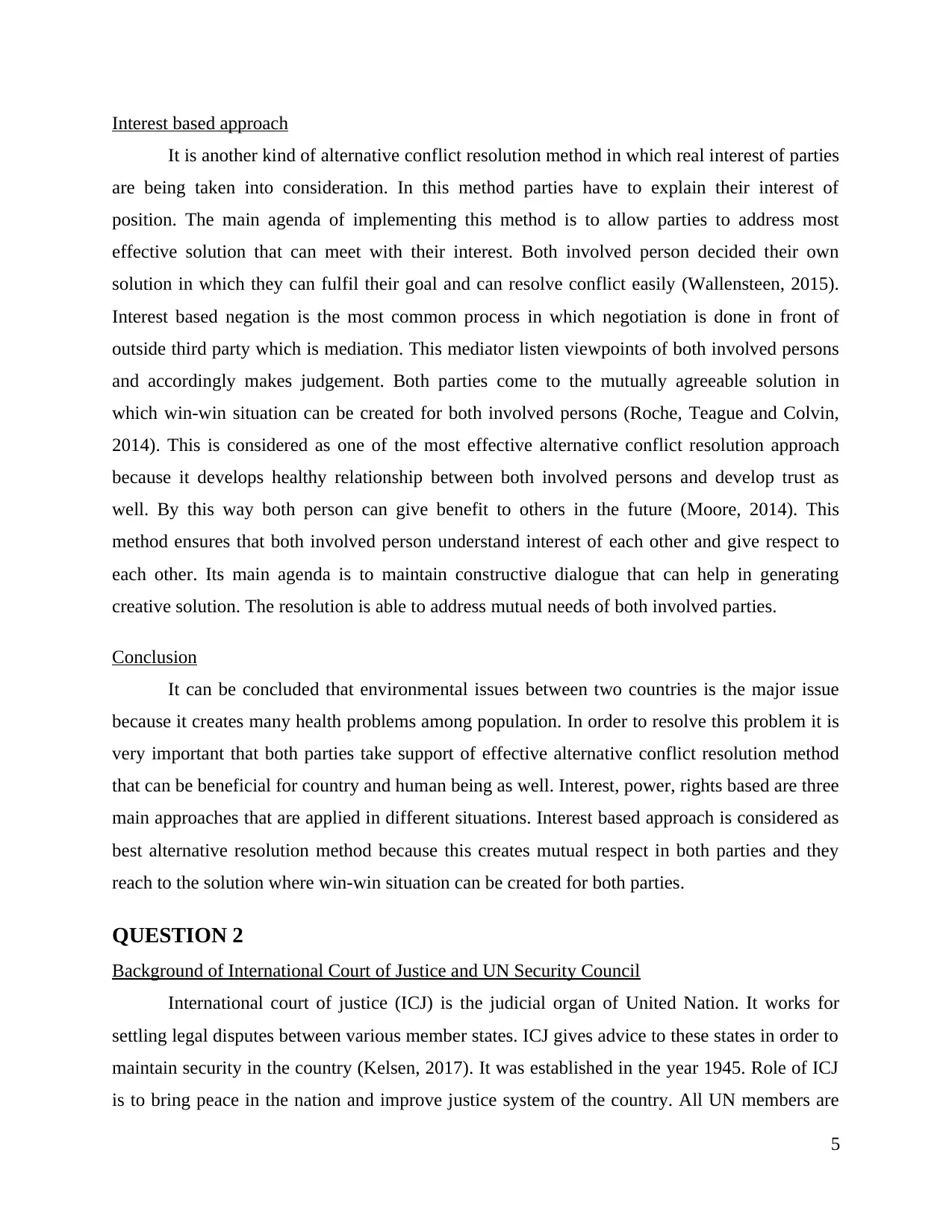
Interest based approach
It is another kind of alternative conflict resolution method in which real interest of parties
are being taken into consideration. In this method parties have to explain their interest of
position. The main agenda of implementing this method is to allow parties to address most
effective solution that can meet with their interest. Both involved person decided their own
solution in which they can fulfil their goal and can resolve conflict easily (Wallensteen, 2015).
Interest based negation is the most common process in which negotiation is done in front of
outside third party which is mediation. This mediator listen viewpoints of both involved persons
and accordingly makes judgement. Both parties come to the mutually agreeable solution in
which win-win situation can be created for both involved persons (Roche, Teague and Colvin,
2014). This is considered as one of the most effective alternative conflict resolution approach
because it develops healthy relationship between both involved persons and develop trust as
well. By this way both person can give benefit to others in the future (Moore, 2014). This
method ensures that both involved person understand interest of each other and give respect to
each other. Its main agenda is to maintain constructive dialogue that can help in generating
creative solution. The resolution is able to address mutual needs of both involved parties.
Conclusion
It can be concluded that environmental issues between two countries is the major issue
because it creates many health problems among population. In order to resolve this problem it is
very important that both parties take support of effective alternative conflict resolution method
that can be beneficial for country and human being as well. Interest, power, rights based are three
main approaches that are applied in different situations. Interest based approach is considered as
best alternative resolution method because this creates mutual respect in both parties and they
reach to the solution where win-win situation can be created for both parties.
QUESTION 2
Background of International Court of Justice and UN Security Council
International court of justice (ICJ) is the judicial organ of United Nation. It works for
settling legal disputes between various member states. ICJ gives advice to these states in order to
maintain security in the country (Kelsen, 2017). It was established in the year 1945. Role of ICJ
is to bring peace in the nation and improve justice system of the country. All UN members are
5
It is another kind of alternative conflict resolution method in which real interest of parties
are being taken into consideration. In this method parties have to explain their interest of
position. The main agenda of implementing this method is to allow parties to address most
effective solution that can meet with their interest. Both involved person decided their own
solution in which they can fulfil their goal and can resolve conflict easily (Wallensteen, 2015).
Interest based negation is the most common process in which negotiation is done in front of
outside third party which is mediation. This mediator listen viewpoints of both involved persons
and accordingly makes judgement. Both parties come to the mutually agreeable solution in
which win-win situation can be created for both involved persons (Roche, Teague and Colvin,
2014). This is considered as one of the most effective alternative conflict resolution approach
because it develops healthy relationship between both involved persons and develop trust as
well. By this way both person can give benefit to others in the future (Moore, 2014). This
method ensures that both involved person understand interest of each other and give respect to
each other. Its main agenda is to maintain constructive dialogue that can help in generating
creative solution. The resolution is able to address mutual needs of both involved parties.
Conclusion
It can be concluded that environmental issues between two countries is the major issue
because it creates many health problems among population. In order to resolve this problem it is
very important that both parties take support of effective alternative conflict resolution method
that can be beneficial for country and human being as well. Interest, power, rights based are three
main approaches that are applied in different situations. Interest based approach is considered as
best alternative resolution method because this creates mutual respect in both parties and they
reach to the solution where win-win situation can be created for both parties.
QUESTION 2
Background of International Court of Justice and UN Security Council
International court of justice (ICJ) is the judicial organ of United Nation. It works for
settling legal disputes between various member states. ICJ gives advice to these states in order to
maintain security in the country (Kelsen, 2017). It was established in the year 1945. Role of ICJ
is to bring peace in the nation and improve justice system of the country. All UN members are
5
Paraphrase This Document
Need a fresh take? Get an instant paraphrase of this document with our AI Paraphraser
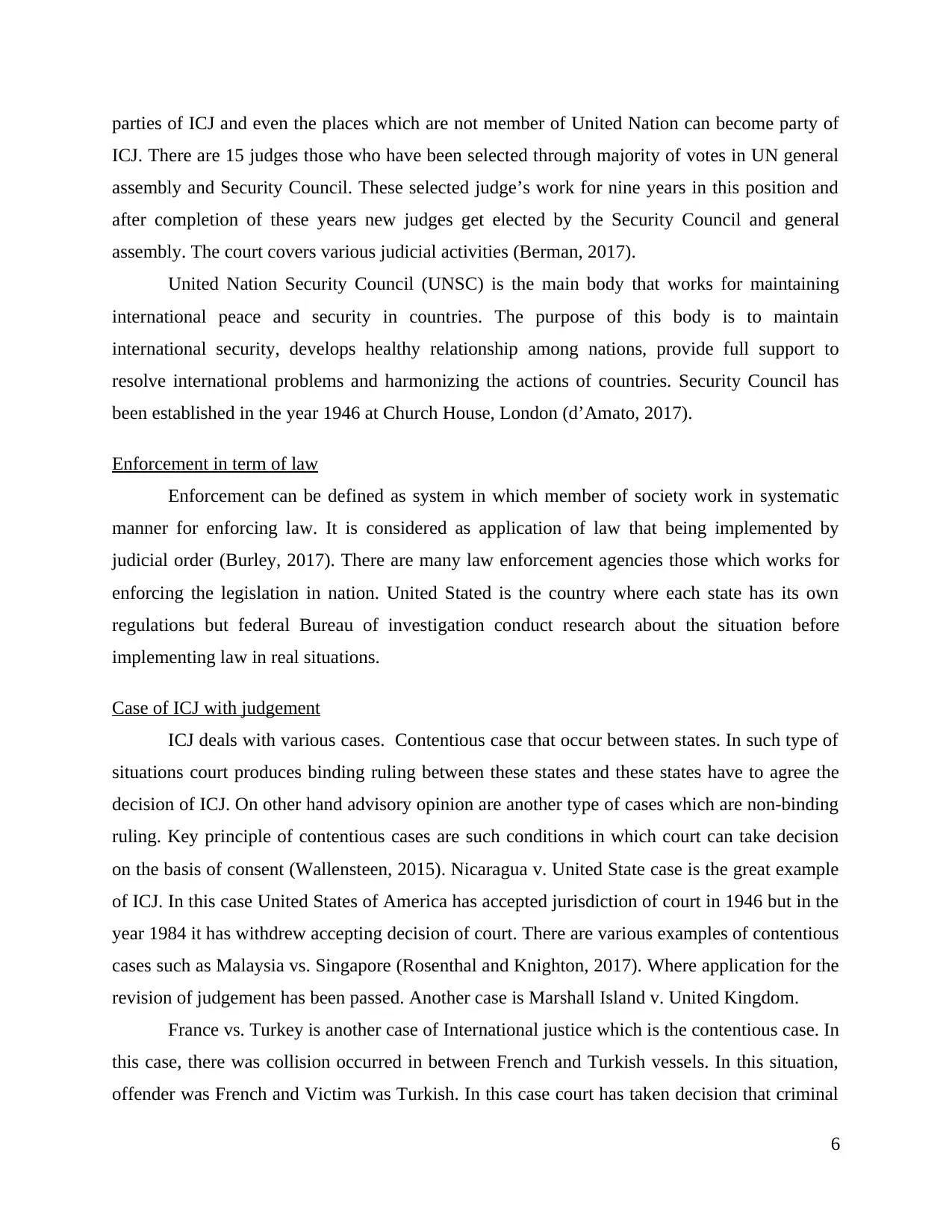
parties of ICJ and even the places which are not member of United Nation can become party of
ICJ. There are 15 judges those who have been selected through majority of votes in UN general
assembly and Security Council. These selected judge’s work for nine years in this position and
after completion of these years new judges get elected by the Security Council and general
assembly. The court covers various judicial activities (Berman, 2017).
United Nation Security Council (UNSC) is the main body that works for maintaining
international peace and security in countries. The purpose of this body is to maintain
international security, develops healthy relationship among nations, provide full support to
resolve international problems and harmonizing the actions of countries. Security Council has
been established in the year 1946 at Church House, London (d’Amato, 2017).
Enforcement in term of law
Enforcement can be defined as system in which member of society work in systematic
manner for enforcing law. It is considered as application of law that being implemented by
judicial order (Burley, 2017). There are many law enforcement agencies those which works for
enforcing the legislation in nation. United Stated is the country where each state has its own
regulations but federal Bureau of investigation conduct research about the situation before
implementing law in real situations.
Case of ICJ with judgement
ICJ deals with various cases. Contentious case that occur between states. In such type of
situations court produces binding ruling between these states and these states have to agree the
decision of ICJ. On other hand advisory opinion are another type of cases which are non-binding
ruling. Key principle of contentious cases are such conditions in which court can take decision
on the basis of consent (Wallensteen, 2015). Nicaragua v. United State case is the great example
of ICJ. In this case United States of America has accepted jurisdiction of court in 1946 but in the
year 1984 it has withdrew accepting decision of court. There are various examples of contentious
cases such as Malaysia vs. Singapore (Rosenthal and Knighton, 2017). Where application for the
revision of judgement has been passed. Another case is Marshall Island v. United Kingdom.
France vs. Turkey is another case of International justice which is the contentious case. In
this case, there was collision occurred in between French and Turkish vessels. In this situation,
offender was French and Victim was Turkish. In this case court has taken decision that criminal
6
ICJ. There are 15 judges those who have been selected through majority of votes in UN general
assembly and Security Council. These selected judge’s work for nine years in this position and
after completion of these years new judges get elected by the Security Council and general
assembly. The court covers various judicial activities (Berman, 2017).
United Nation Security Council (UNSC) is the main body that works for maintaining
international peace and security in countries. The purpose of this body is to maintain
international security, develops healthy relationship among nations, provide full support to
resolve international problems and harmonizing the actions of countries. Security Council has
been established in the year 1946 at Church House, London (d’Amato, 2017).
Enforcement in term of law
Enforcement can be defined as system in which member of society work in systematic
manner for enforcing law. It is considered as application of law that being implemented by
judicial order (Burley, 2017). There are many law enforcement agencies those which works for
enforcing the legislation in nation. United Stated is the country where each state has its own
regulations but federal Bureau of investigation conduct research about the situation before
implementing law in real situations.
Case of ICJ with judgement
ICJ deals with various cases. Contentious case that occur between states. In such type of
situations court produces binding ruling between these states and these states have to agree the
decision of ICJ. On other hand advisory opinion are another type of cases which are non-binding
ruling. Key principle of contentious cases are such conditions in which court can take decision
on the basis of consent (Wallensteen, 2015). Nicaragua v. United State case is the great example
of ICJ. In this case United States of America has accepted jurisdiction of court in 1946 but in the
year 1984 it has withdrew accepting decision of court. There are various examples of contentious
cases such as Malaysia vs. Singapore (Rosenthal and Knighton, 2017). Where application for the
revision of judgement has been passed. Another case is Marshall Island v. United Kingdom.
France vs. Turkey is another case of International justice which is the contentious case. In
this case, there was collision occurred in between French and Turkish vessels. In this situation,
offender was French and Victim was Turkish. In this case court has taken decision that criminal
6
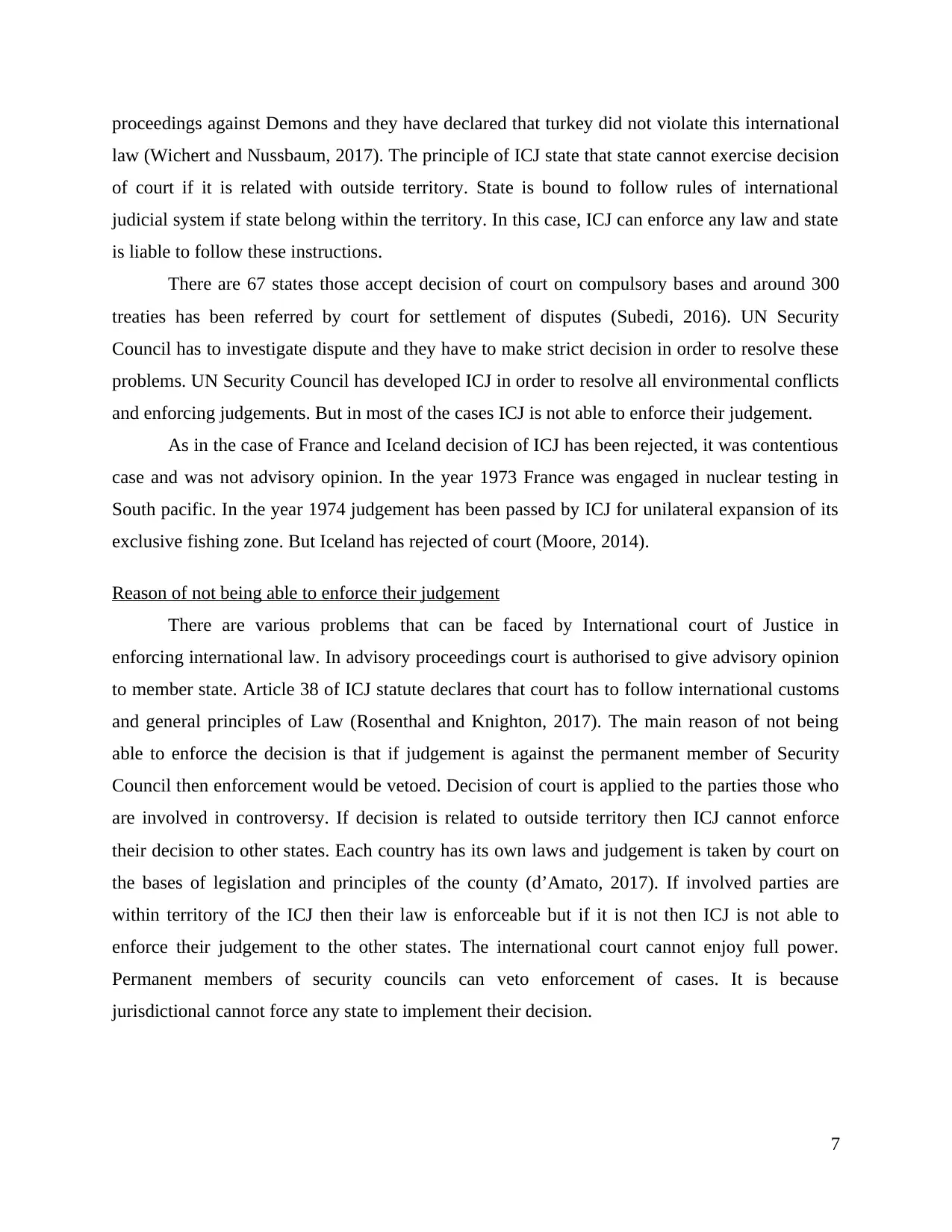
proceedings against Demons and they have declared that turkey did not violate this international
law (Wichert and Nussbaum, 2017). The principle of ICJ state that state cannot exercise decision
of court if it is related with outside territory. State is bound to follow rules of international
judicial system if state belong within the territory. In this case, ICJ can enforce any law and state
is liable to follow these instructions.
There are 67 states those accept decision of court on compulsory bases and around 300
treaties has been referred by court for settlement of disputes (Subedi, 2016). UN Security
Council has to investigate dispute and they have to make strict decision in order to resolve these
problems. UN Security Council has developed ICJ in order to resolve all environmental conflicts
and enforcing judgements. But in most of the cases ICJ is not able to enforce their judgement.
As in the case of France and Iceland decision of ICJ has been rejected, it was contentious
case and was not advisory opinion. In the year 1973 France was engaged in nuclear testing in
South pacific. In the year 1974 judgement has been passed by ICJ for unilateral expansion of its
exclusive fishing zone. But Iceland has rejected of court (Moore, 2014).
Reason of not being able to enforce their judgement
There are various problems that can be faced by International court of Justice in
enforcing international law. In advisory proceedings court is authorised to give advisory opinion
to member state. Article 38 of ICJ statute declares that court has to follow international customs
and general principles of Law (Rosenthal and Knighton, 2017). The main reason of not being
able to enforce the decision is that if judgement is against the permanent member of Security
Council then enforcement would be vetoed. Decision of court is applied to the parties those who
are involved in controversy. If decision is related to outside territory then ICJ cannot enforce
their decision to other states. Each country has its own laws and judgement is taken by court on
the bases of legislation and principles of the county (d’Amato, 2017). If involved parties are
within territory of the ICJ then their law is enforceable but if it is not then ICJ is not able to
enforce their judgement to the other states. The international court cannot enjoy full power.
Permanent members of security councils can veto enforcement of cases. It is because
jurisdictional cannot force any state to implement their decision.
7
law (Wichert and Nussbaum, 2017). The principle of ICJ state that state cannot exercise decision
of court if it is related with outside territory. State is bound to follow rules of international
judicial system if state belong within the territory. In this case, ICJ can enforce any law and state
is liable to follow these instructions.
There are 67 states those accept decision of court on compulsory bases and around 300
treaties has been referred by court for settlement of disputes (Subedi, 2016). UN Security
Council has to investigate dispute and they have to make strict decision in order to resolve these
problems. UN Security Council has developed ICJ in order to resolve all environmental conflicts
and enforcing judgements. But in most of the cases ICJ is not able to enforce their judgement.
As in the case of France and Iceland decision of ICJ has been rejected, it was contentious
case and was not advisory opinion. In the year 1973 France was engaged in nuclear testing in
South pacific. In the year 1974 judgement has been passed by ICJ for unilateral expansion of its
exclusive fishing zone. But Iceland has rejected of court (Moore, 2014).
Reason of not being able to enforce their judgement
There are various problems that can be faced by International court of Justice in
enforcing international law. In advisory proceedings court is authorised to give advisory opinion
to member state. Article 38 of ICJ statute declares that court has to follow international customs
and general principles of Law (Rosenthal and Knighton, 2017). The main reason of not being
able to enforce the decision is that if judgement is against the permanent member of Security
Council then enforcement would be vetoed. Decision of court is applied to the parties those who
are involved in controversy. If decision is related to outside territory then ICJ cannot enforce
their decision to other states. Each country has its own laws and judgement is taken by court on
the bases of legislation and principles of the county (d’Amato, 2017). If involved parties are
within territory of the ICJ then their law is enforceable but if it is not then ICJ is not able to
enforce their judgement to the other states. The international court cannot enjoy full power.
Permanent members of security councils can veto enforcement of cases. It is because
jurisdictional cannot force any state to implement their decision.
7
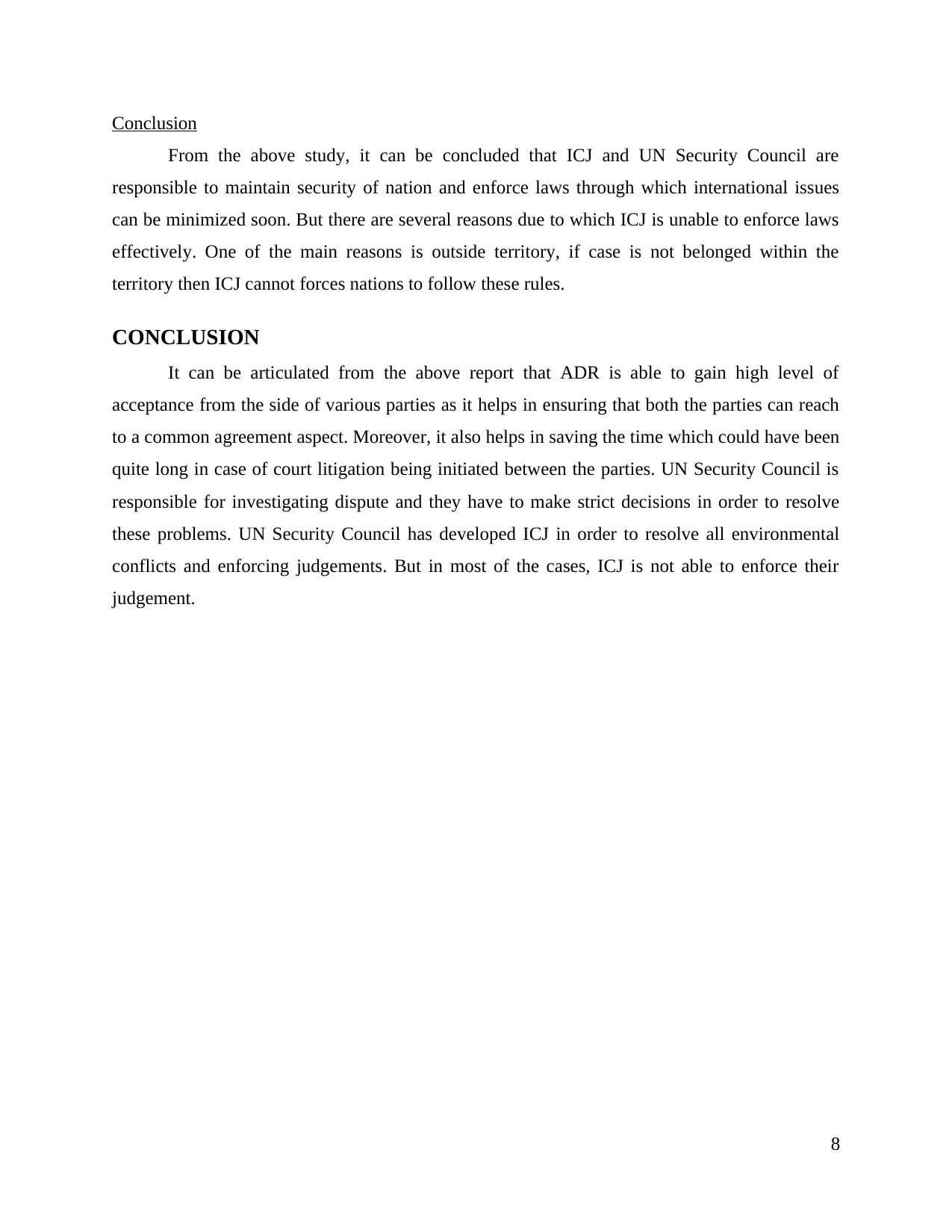
Conclusion
From the above study, it can be concluded that ICJ and UN Security Council are
responsible to maintain security of nation and enforce laws through which international issues
can be minimized soon. But there are several reasons due to which ICJ is unable to enforce laws
effectively. One of the main reasons is outside territory, if case is not belonged within the
territory then ICJ cannot forces nations to follow these rules.
CONCLUSION
It can be articulated from the above report that ADR is able to gain high level of
acceptance from the side of various parties as it helps in ensuring that both the parties can reach
to a common agreement aspect. Moreover, it also helps in saving the time which could have been
quite long in case of court litigation being initiated between the parties. UN Security Council is
responsible for investigating dispute and they have to make strict decisions in order to resolve
these problems. UN Security Council has developed ICJ in order to resolve all environmental
conflicts and enforcing judgements. But in most of the cases, ICJ is not able to enforce their
judgement.
8
From the above study, it can be concluded that ICJ and UN Security Council are
responsible to maintain security of nation and enforce laws through which international issues
can be minimized soon. But there are several reasons due to which ICJ is unable to enforce laws
effectively. One of the main reasons is outside territory, if case is not belonged within the
territory then ICJ cannot forces nations to follow these rules.
CONCLUSION
It can be articulated from the above report that ADR is able to gain high level of
acceptance from the side of various parties as it helps in ensuring that both the parties can reach
to a common agreement aspect. Moreover, it also helps in saving the time which could have been
quite long in case of court litigation being initiated between the parties. UN Security Council is
responsible for investigating dispute and they have to make strict decisions in order to resolve
these problems. UN Security Council has developed ICJ in order to resolve all environmental
conflicts and enforcing judgements. But in most of the cases, ICJ is not able to enforce their
judgement.
8
Secure Best Marks with AI Grader
Need help grading? Try our AI Grader for instant feedback on your assignments.
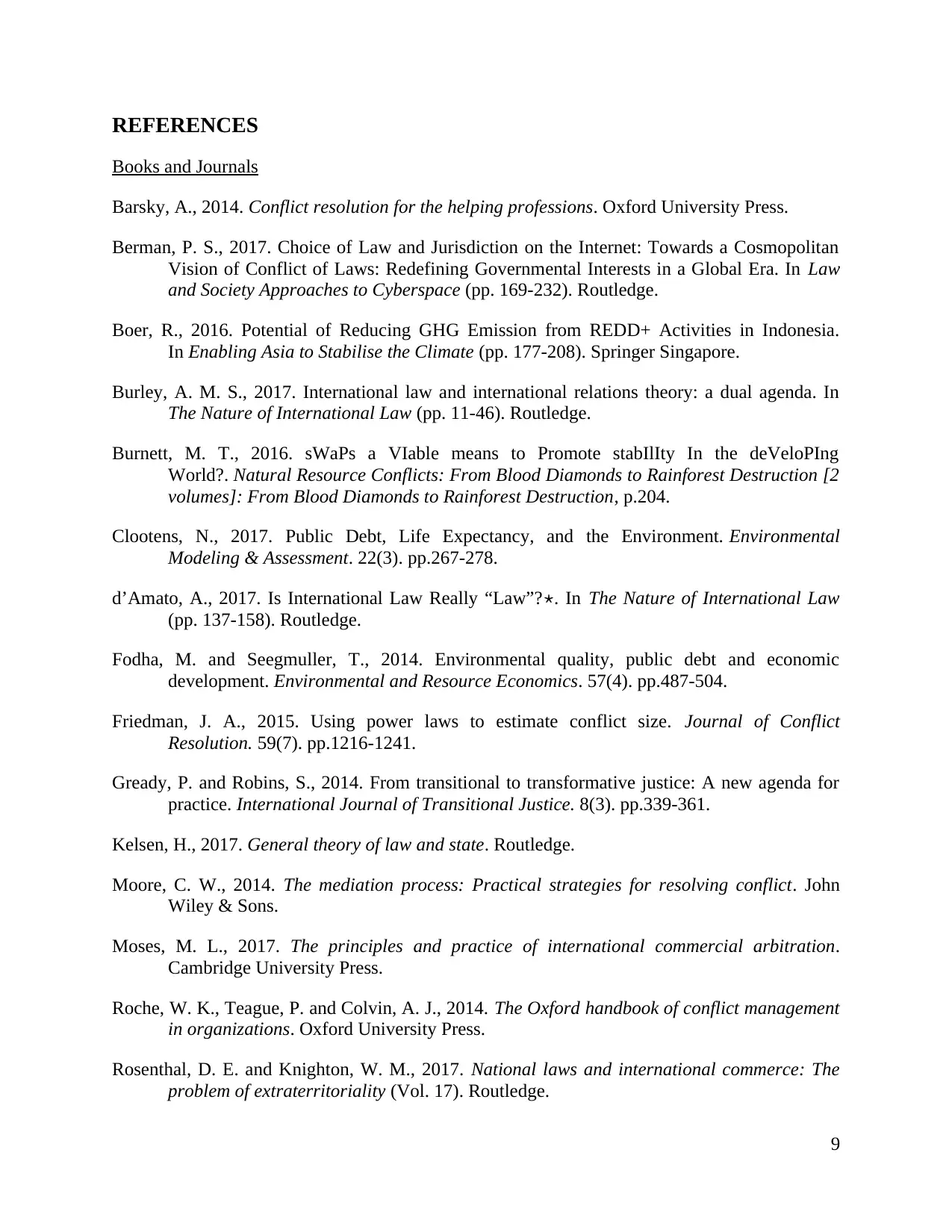
REFERENCES
Books and Journals
Barsky, A., 2014. Conflict resolution for the helping professions. Oxford University Press.
Berman, P. S., 2017. Choice of Law and Jurisdiction on the Internet: Towards a Cosmopolitan
Vision of Conflict of Laws: Redefining Governmental Interests in a Global Era. In Law
and Society Approaches to Cyberspace (pp. 169-232). Routledge.
Boer, R., 2016. Potential of Reducing GHG Emission from REDD+ Activities in Indonesia.
In Enabling Asia to Stabilise the Climate (pp. 177-208). Springer Singapore.
Burley, A. M. S., 2017. International law and international relations theory: a dual agenda. In
The Nature of International Law (pp. 11-46). Routledge.
Burnett, M. T., 2016. sWaPs a VIable means to Promote stabIlIty In the deVeloPIng
World?. Natural Resource Conflicts: From Blood Diamonds to Rainforest Destruction [2
volumes]: From Blood Diamonds to Rainforest Destruction, p.204.
Clootens, N., 2017. Public Debt, Life Expectancy, and the Environment. Environmental
Modeling & Assessment. 22(3). pp.267-278.
d’Amato, A., 2017. Is International Law Really “Law”? . In⋆ The Nature of International Law
(pp. 137-158). Routledge.
Fodha, M. and Seegmuller, T., 2014. Environmental quality, public debt and economic
development. Environmental and Resource Economics. 57(4). pp.487-504.
Friedman, J. A., 2015. Using power laws to estimate conflict size. Journal of Conflict
Resolution. 59(7). pp.1216-1241.
Gready, P. and Robins, S., 2014. From transitional to transformative justice: A new agenda for
practice. International Journal of Transitional Justice. 8(3). pp.339-361.
Kelsen, H., 2017. General theory of law and state. Routledge.
Moore, C. W., 2014. The mediation process: Practical strategies for resolving conflict. John
Wiley & Sons.
Moses, M. L., 2017. The principles and practice of international commercial arbitration.
Cambridge University Press.
Roche, W. K., Teague, P. and Colvin, A. J., 2014. The Oxford handbook of conflict management
in organizations. Oxford University Press.
Rosenthal, D. E. and Knighton, W. M., 2017. National laws and international commerce: The
problem of extraterritoriality (Vol. 17). Routledge.
9
Books and Journals
Barsky, A., 2014. Conflict resolution for the helping professions. Oxford University Press.
Berman, P. S., 2017. Choice of Law and Jurisdiction on the Internet: Towards a Cosmopolitan
Vision of Conflict of Laws: Redefining Governmental Interests in a Global Era. In Law
and Society Approaches to Cyberspace (pp. 169-232). Routledge.
Boer, R., 2016. Potential of Reducing GHG Emission from REDD+ Activities in Indonesia.
In Enabling Asia to Stabilise the Climate (pp. 177-208). Springer Singapore.
Burley, A. M. S., 2017. International law and international relations theory: a dual agenda. In
The Nature of International Law (pp. 11-46). Routledge.
Burnett, M. T., 2016. sWaPs a VIable means to Promote stabIlIty In the deVeloPIng
World?. Natural Resource Conflicts: From Blood Diamonds to Rainforest Destruction [2
volumes]: From Blood Diamonds to Rainforest Destruction, p.204.
Clootens, N., 2017. Public Debt, Life Expectancy, and the Environment. Environmental
Modeling & Assessment. 22(3). pp.267-278.
d’Amato, A., 2017. Is International Law Really “Law”? . In⋆ The Nature of International Law
(pp. 137-158). Routledge.
Fodha, M. and Seegmuller, T., 2014. Environmental quality, public debt and economic
development. Environmental and Resource Economics. 57(4). pp.487-504.
Friedman, J. A., 2015. Using power laws to estimate conflict size. Journal of Conflict
Resolution. 59(7). pp.1216-1241.
Gready, P. and Robins, S., 2014. From transitional to transformative justice: A new agenda for
practice. International Journal of Transitional Justice. 8(3). pp.339-361.
Kelsen, H., 2017. General theory of law and state. Routledge.
Moore, C. W., 2014. The mediation process: Practical strategies for resolving conflict. John
Wiley & Sons.
Moses, M. L., 2017. The principles and practice of international commercial arbitration.
Cambridge University Press.
Roche, W. K., Teague, P. and Colvin, A. J., 2014. The Oxford handbook of conflict management
in organizations. Oxford University Press.
Rosenthal, D. E. and Knighton, W. M., 2017. National laws and international commerce: The
problem of extraterritoriality (Vol. 17). Routledge.
9
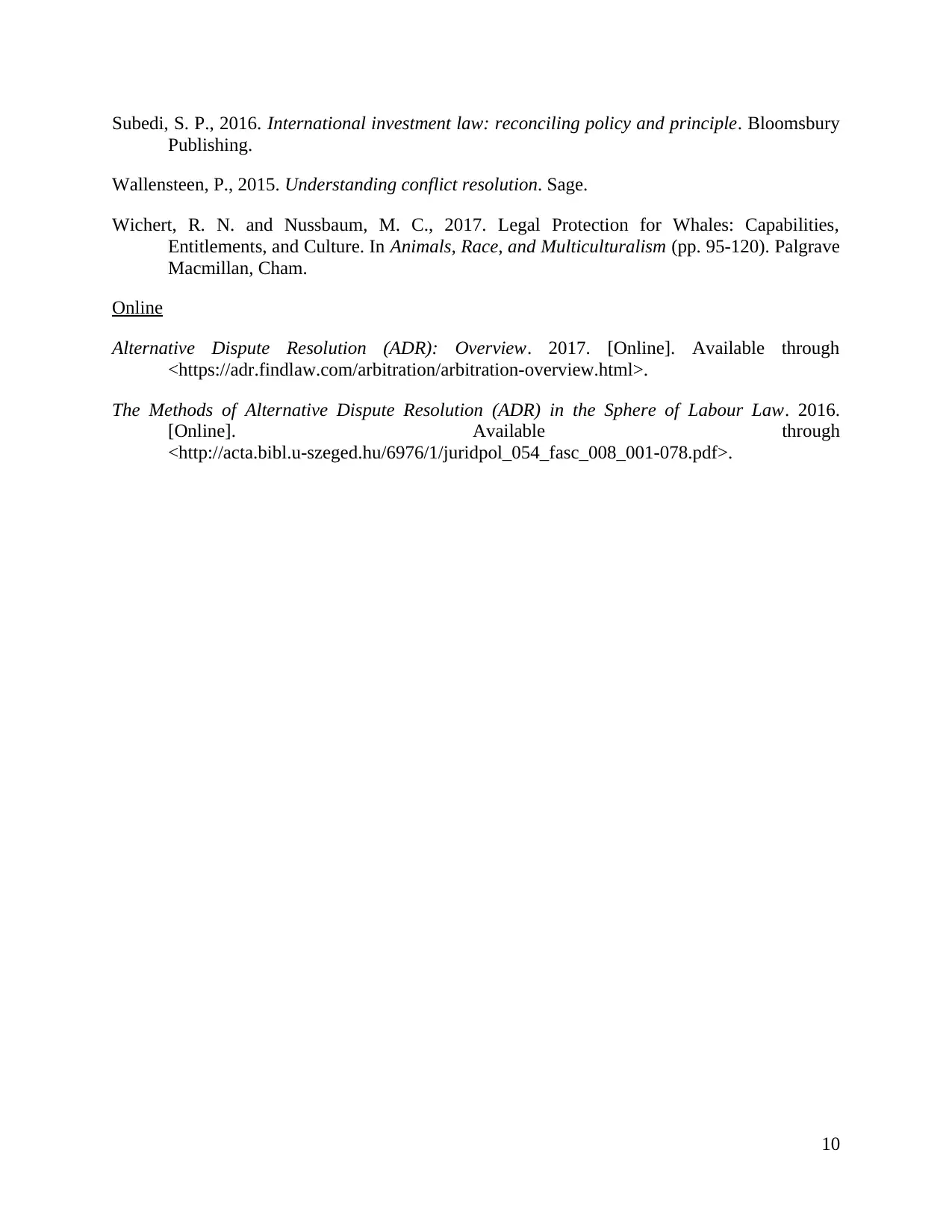
Subedi, S. P., 2016. International investment law: reconciling policy and principle. Bloomsbury
Publishing.
Wallensteen, P., 2015. Understanding conflict resolution. Sage.
Wichert, R. N. and Nussbaum, M. C., 2017. Legal Protection for Whales: Capabilities,
Entitlements, and Culture. In Animals, Race, and Multiculturalism (pp. 95-120). Palgrave
Macmillan, Cham.
Online
Alternative Dispute Resolution (ADR): Overview. 2017. [Online]. Available through
<https://adr.findlaw.com/arbitration/arbitration-overview.html>.
The Methods of Alternative Dispute Resolution (ADR) in the Sphere of Labour Law. 2016.
[Online]. Available through
<http://acta.bibl.u-szeged.hu/6976/1/juridpol_054_fasc_008_001-078.pdf>.
10
Publishing.
Wallensteen, P., 2015. Understanding conflict resolution. Sage.
Wichert, R. N. and Nussbaum, M. C., 2017. Legal Protection for Whales: Capabilities,
Entitlements, and Culture. In Animals, Race, and Multiculturalism (pp. 95-120). Palgrave
Macmillan, Cham.
Online
Alternative Dispute Resolution (ADR): Overview. 2017. [Online]. Available through
<https://adr.findlaw.com/arbitration/arbitration-overview.html>.
The Methods of Alternative Dispute Resolution (ADR) in the Sphere of Labour Law. 2016.
[Online]. Available through
<http://acta.bibl.u-szeged.hu/6976/1/juridpol_054_fasc_008_001-078.pdf>.
10
1 out of 12
Related Documents
Your All-in-One AI-Powered Toolkit for Academic Success.
+13062052269
info@desklib.com
Available 24*7 on WhatsApp / Email
![[object Object]](/_next/static/media/star-bottom.7253800d.svg)
Unlock your academic potential
© 2024 | Zucol Services PVT LTD | All rights reserved.





